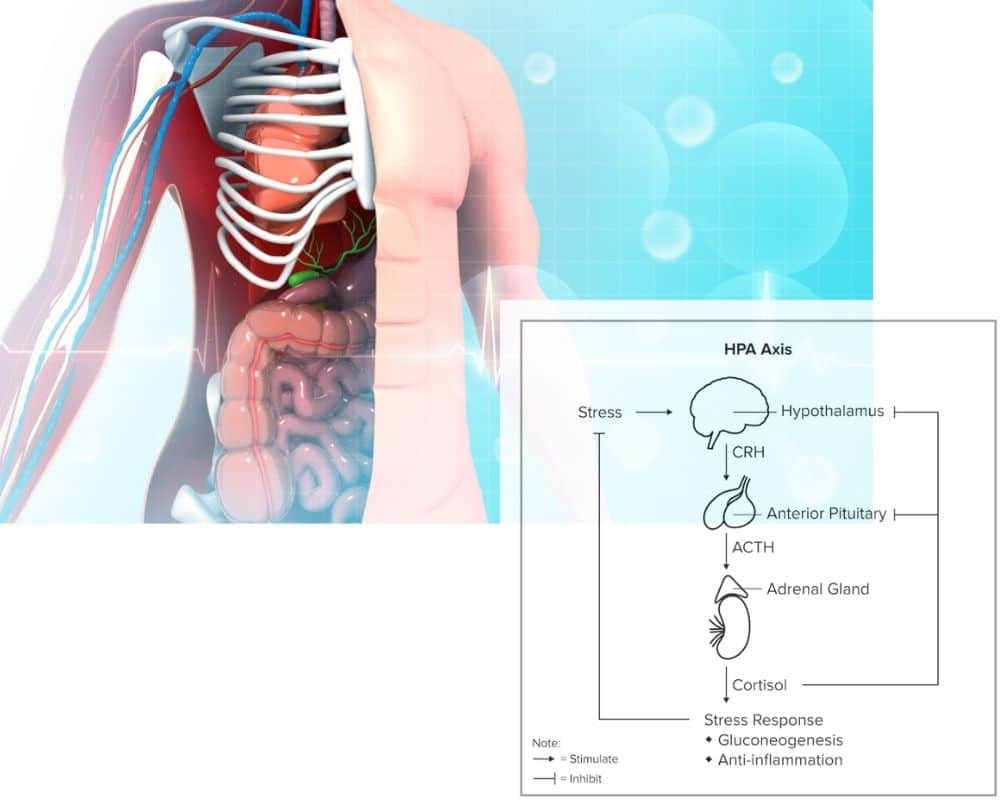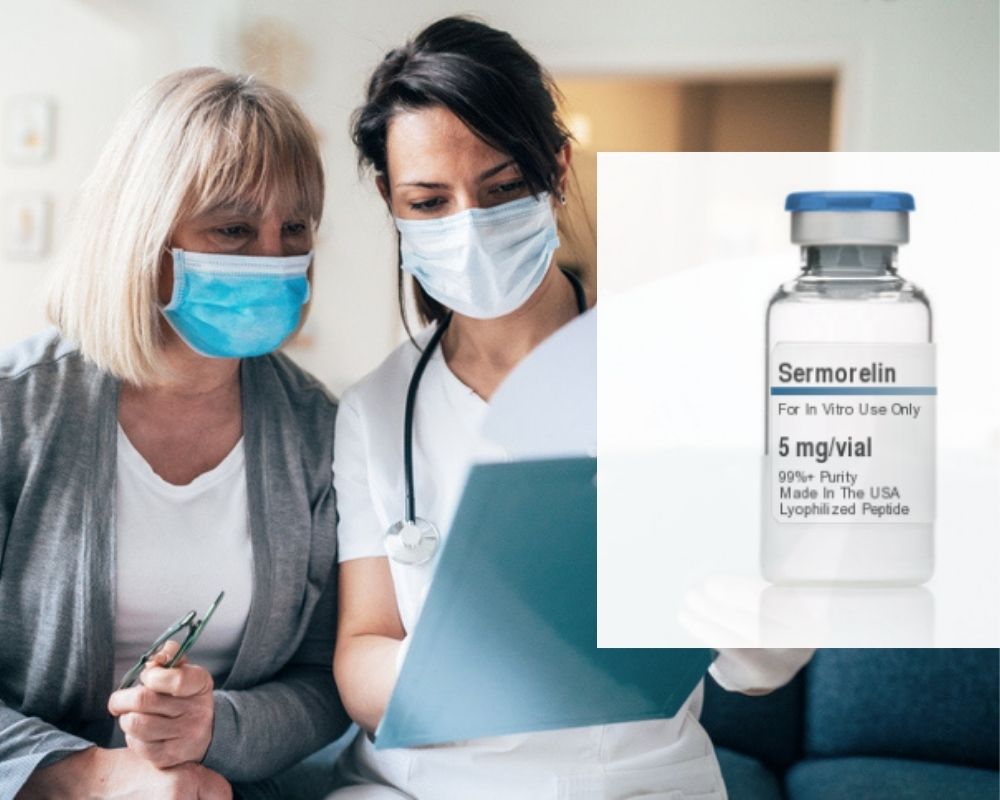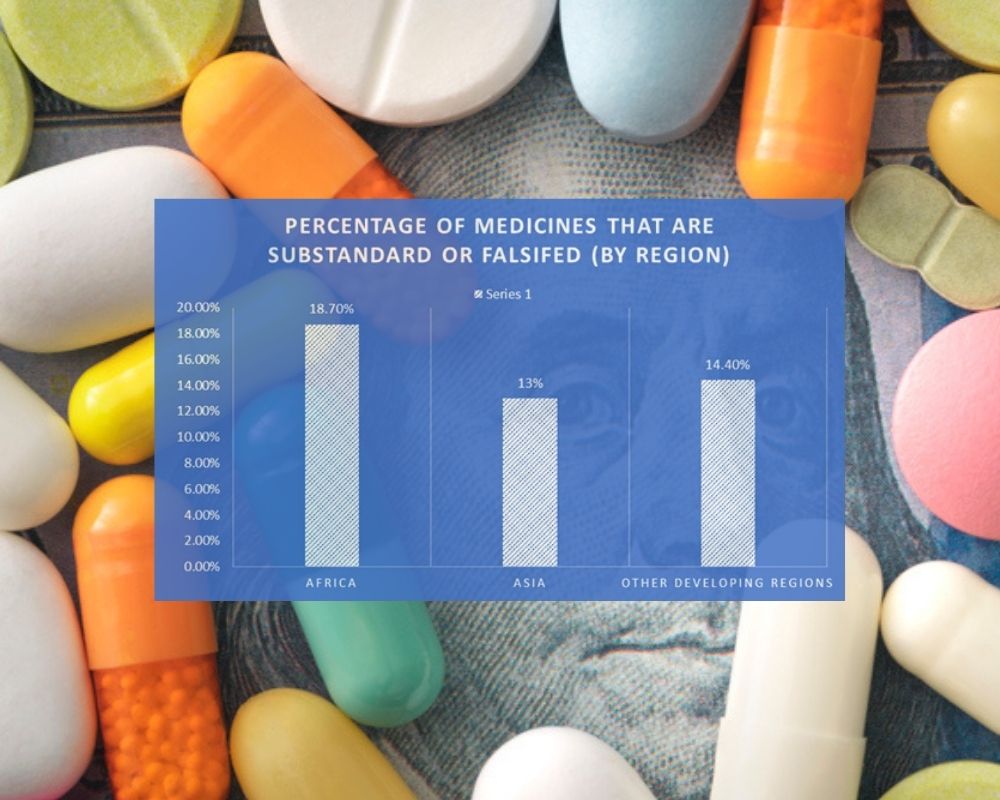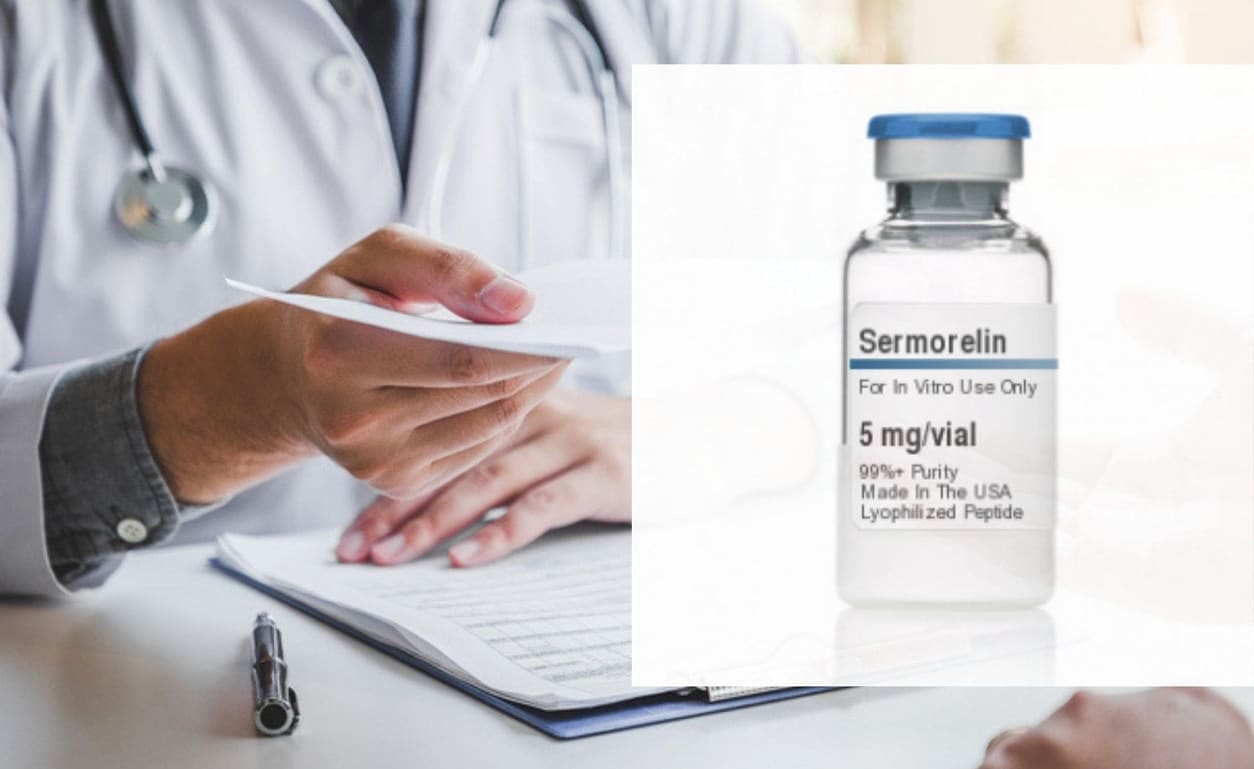
Where Is the Best Place to Purchase Sermorelin?
Table of Contents
Sermorelin – in long-form, “sermorelin acetate” – is a popular and effective medication used to boost endogenous HGH production in patients with a diagnosed growth hormone disorder (GHD). Here, we will explore the various healthcare applications of Sermorelin, its relative benefits compared to other HGH-boosting medications, its risks, and the best places to purchase Sermorelin for US patients.
Let’s start off this review of with a brief overview of Sermorelin and how it can restore healthy HGH levels in patients affected by hormone imbalances.
What Is Sermorelin and How Does It Work?
Sermorelin is an analog of human growth hormone-releasing hormone (GHRH), meaning that it mimics the molecular structure of GHRH, a hormone responsible for regulating the release of the pro-growth hormone HGH. Sermorelin contains the first 29 amino acids in the GHRH sequence out of a total of 44, making it a shorter synthetic peptide than the actual GHRH hormone while retaining all of the biological effectiveness (bioefficacy) of GHRH. The earliest forms of growth hormone secretagogues were developed in the 1970s. Shortly thereafter, the 29-amino-acid GHRH analog Sermorelin was developed. It quickly gained popularity among the medical community for its effectiveness in spurring HGH release without producing the negative side effects often seen in other HGH secretagogues:
“Sermorelin specifically stimulates GH secretion from the pituitary gland without any significant change in prolactin, luteinizing hormone, follicle-stimulating hormone, insulin, cortisol, glucose, glucagon, or thyroid hormone levels.”
In the United States, Sermorelin first hit the market for purchase with a prescription in 1997 after it was approved for therapeutic use – considered by many to be the gold standard for safety and effectiveness of medications. Due to difficulties sourcing the raw materials needed to manufacture Sermorelin, its use was halted in 2008. However, it has recently again become a medication of interest among endocrinologists in the anti-aging field for its well-documented efficacy and minimal risk profile.
How Does Sermorelin Boost HGH Levels in Adults With Deficiencies?
Sermorelin produces its beneficial effects – namely, boosting HGH levels – by acting just like naturally occurring GHRH. GHRH is a critical component of the hypothalamic-pituitary-adrenal axis (HPA axis), an interconnected network of glands and hormones that direct various activities of numerous hormones, including regulating the production and release of HGH.
The hypothalamus releases the 44-peptide amino acid GHRH molecule into the hypothalamohypophyseal portal system, where it travels to the anterior pituitary gland to trigger the release of HGH. In healthy individuals, the activities of GHRH are kept in check by its counter-hormone, somatostatin (growth hormone-inhibiting hormone). In this way, HGH levels are maintained at optimal levels. Sermorelin is an effective therapeutic tool that has been used to help adults with growth hormone deficiencies naturally elevate their blood concentrations of HGH to achieve normal, healthy levels.
| Normal HGH Levels in Adults | |
| Men | 0.4-10 ng/mL |
| Women | 1-14 ng/mL |
Sermorelin, when used correctly, will prevent the worst effects of GHD by supporting healthy HGH levels. What are those negative health outcomes of GHD for adults who suffer from the condition? We will explore them in the following section.
What Are the Negative Health Effects of Growth Hormone Disorder (GHD)?
Growth hormone disorder (GHD) can wreak havoc on health.
- Loss of lean muscle mass
- Low libido (loss of interest in sex)
- Hoarse voice
- Muscle weakness
- Dry skin
- Thinning hair
- Unwanted weight gain (especially belly fat, of “visceral fat”)
- Chronic fatigue (low energy levels)
- Cold sensitivity
- Osteoporosis (bone weakening)
Unfortunately, natural HGH levels tend to decline with age. The risk of HGH deficiency grows across time, with adults over age 40 being at the greatest risk, particularly women going through menopause.
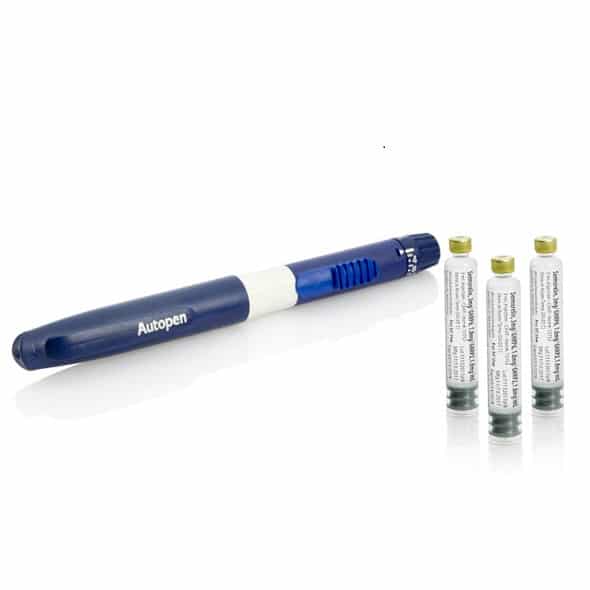
Sermorelin vs. Bioidentical Human Growth Hormone (HGH): What’s the Difference?
Understandably, Sermorelin is often confused with other HGH products such as somatropin. However, there are important distinctions that are worth exploring. Let’s get into the differences between Sermorelin and other popular supplements to boost HGH levels:
- Somatropin, also known as recombinant human growth hormone or rHGH, is a synthetic version of naturally occurring HGH that is normally produced in healthy individuals by the pituitary gland.
Somatropin perfectly resembles the molecular structure of endogenous HGH, and the body is unable to tell the difference between natural HGH and this form of synthetic HGH. For this reason, these formulations are often referred to as “bioidentical” HGH. Accordingly, somatropin is therefore used to supplement falling HGH levels in patients with diagnosed growth hormone disorder (GHD).
Popular brands of somatropin sold in the United States include Genotropin (Pfizer), Humatrope (Eli Lilly), Saizen (EMD Serono), and Omnitrope (Sandoz).
- Sermorelin, on the other hand, is not a synthetic form of natural HGH. Rather, it is known as a human growth hormone-releasing hormone (GHRH) because it triggers the pituitary gland to produce and release natural HGH.
Although it was initially designed to be used to test for childhood GHD, Sermorelin is highly successful in off-label use to treat adult GHD as well.
Both Somatropin and Sermorelin have proven track records of success in treating adult GHD. Each has a unique profile of relative benefits and risks, so it’s worth consulting with your hormone specialist (endocrinologist) to discover which one might be ideal for you.
What Are the Health Benefits of Sermorelin for Patients With Growth Hormone Disorder (GHD)?
We previously discussed the negative health consequences of untreated GHD in adults. The good news is that they are highly treatable with the right anti-aging strategy, which may include the administration of Sermorelin.
The potential benefits of hormone replacement therapy (HRT) using Sermorelin are vast and can include:
- Body fat loss (especially dangerous visceral fat, AKA belly fat)
- Increased lean body mass
- Faster, more complete wound healing
- Greater energy and vitality
- Boosted endurance and strength
- Better immune system function
- Improved cardiovascular function
- Enhanced sexual performance and libido
- Optimized sleep
In fact, many healthcare practitioners – based on the clinical data – prefer to treat adult GHD patients with Sermorelin rather than synthetic HGH for a number of reasons. A few of these, informed by long-term studies of treated patients as suggested by expert researchers, that might indicate the clinical superiority of Sermorelin for many patients include:
- “Effects are regulated by negative feedback involving the inhibitory neurohormone, somatostatin so that unlike administration of exogenous rhGH, overdoses of endogenous HGH are difficult if not impossible to achieve.”
- “Because of the interactive effects of sermorelin and somatostain, release of hGH by the pituitary is episodic or intermittent rather than constant as with injected rhGH.”
- “Tachphylaxis is avoided because sermorelin-induced release of pituitary hGH is not ‘square wave’, but instead simulates more normal physiology.’
- “Sermorelin stimulates pituitary gene transcription of hGH messenger RNA, increasing pituitary reserve and thereby preserving more of the growth hormone neuroendocrine axis, which is the first to fail during aging.”
- “Pituitary recrudescence resulting from sermorelin helps slow the cascade of hypophyseal hormone failure that occurs during aging thereby preserving not only youthful anatomy but also youthful physiology.”
Now that we’ve explored the health benefits of hormone replacement therapy (HRT) using Sermorelin and discussed the potential advantages of Sermorelin over synthetic HGH, let’s get into how to find high-quality, safe, effective Sermorelin if you are a US patient.
Your Options for Sourcing Sermorelin and Important Considerations
As an American, you have several options in terms of where to source your Sermorelin. We’ve broken down the relative advantages, disadvantages, and important safety tips below:
General Practitioner (GP)
This is the most common source of prescriptions that patients rely on to source their medications. A general practitioner, or GP, is a “jack of all trades” physician – he or she is not necessarily an expert in any one area of medicine but rather has a working knowledge of a large range of topics.
GP Pros: Easy to book appointments, GPs are widely available in most areas and less expensive (usually) than specialists.
GP Cons: GPs are not necessarily experts in endocrinology (hormone medicine) and as such may be limited in the assistance they are able to offer.
Endocrinologist
An endocrinologist is a doctor whose main expertise is as a hormone specialist, meaning he or she spent significant amount of time in medical school and then in residency afterward training to become an expert at identifying health conditions related to the hormone system and treating them accordingly.
Endocrinologist Pros; These are seasoned, well-trained hormone experts who are more likely than GPs to be familiar with hormonal conditions, to identify them correctly, and to prescribe the correct course of treatment. He or she is likely to be familiar with the benefits and risks of Sermorelin and can advise you accordingly.
Endocrinologist Cons: These are generally more expensive than GPs due to their specialized nature. In many healthcare systems, you may also need a referral from a GP – who often act as gatekeepers – before you can make an appointment.
Online Clinic (Telemedicine)
Telemedicine is an exciting new treatment modality that connects patients and providers using telecommunication technology (hence the name). In most situations, this means video-conferencing across the web.
Telemedicine Pros: Consulting with a healthcare provider via the web is exceptionally convenient, and makes accessing vital care a much smoother process, particularly in an era of social distancing.
Telemedicine Cons: Requires access to equipment and internet connection. Some patients may feel the experience is not as “personal” as they might like. There is also a lack of physical examination that can occur in an in-person meeting.
Specialized Clinic (Dedicated HRT Facility)
A dedicated HRT facility does one thing and one thing only: treats patients with hormonal balances to restore quality of life, boost mental, spiritual, and physical well-being, and limit the risk of age-related common illness.
Dedicated HRT Facility Pros: Treating hormone deficiencies, including adult-onset GHD, is the single mission of a dedicated HRT facility. If you go to the right one, the doctors you will meet there are likely to have combined decades of experience treating hundreds –perhaps thousands – of patients who have experienced and recovered from hormone HGH deficiencies just like yours. They are familiar with the entire spectrum of medications that can be used to treat GHD and know how to assess each patient on a case-by-case basis to develop an individualized treatment plan.
Dedicated HRT Facility Cons: There are a limited number of these facilities, and they tend to be concentrated in large urban centers. Demand may also be high, so you may have some difficulty landing an appointment. Additionally, some insurance policies might not cover the procedures performed at these clinics.
Which of These Sermorelin Options Is Ideal For You?
A high-quality, expertly-staffed dedicated HRT facility is, without question, the ideal source for therapy to treat GHD. The standout benefits of dedicated HRT facilities over the other options explored in the previous section include:
- Expert staff that has trained and practiced (again, often for decades) in the management of hormones and optimal treatments for deficiencies, including GHD
- Reviews often widely available on the web
- Well-developed protocols for treating hormone-related conditions
- Holistic, anti-aging healthcare oriented not only toward treating disease but toward building wellness and improving quality of life over the long term
- Access to cutting-edge technologies and therapeutics (including Sermorelin) not available in standard clinics
- Labs and pharmacies are often located on-site for maximum convenience
- Limited or eliminated government red tape on what procedures or medications are allowed, putting control back where it should be: between you and your doctor
Frequently Asked Questions (FAQs) About Sermorelin
We’ve put together a handful of FAQs regarding Sermorelin, its dosages, safety info, and cost.
What Is the Ideal Dosage of Sermorelin?
The standard recommended dosage, for the average patient, is 200 – 300 mcg of sermorelin acetate once daily. However, the exact individual dosage that you should take depends on a number of factors including:
- Your age
- Your body mass index (BMI)
- The severity of your deficiency
- Your healthcare goals
Do I Need a Prescription For Sermorelin?
Yes, to legally obtain and use Sermorelin in the United States, you must have a prescription to comply with federal law – one more reason why you should also consult with a licensed doctor (in addition to protecting your health). In the US, Sermorelin is available in four common concentrations:
- 0.5 mg vial: 0.5 mg sermorelin, 5 mg mannitol, pH adjusted w/ dibasic sodium phosphate and monobasic sodium phosphate buffer.
- 3.0 mg vial
- 9.0 mg vial
- 15.0 mg vial
Are There Any Side Effects of Sermorelin?
There are possible side effects of Sermorelin, which is why you should seek the care of a hormonal specialist with experience treating patients using this medication. Although it is largely safe, Sermorelin has been seen to cause these (largely mild) side effects in patients:
- headache
- hives
- difficulty swallowing
- flushing
- dizziness
- hyperactivity
- sleepiness
- injection site reactions (such as pain, swelling, or redness)
Again, most patients handle Sermorelin exceptionally well with minimal, if any, side effects. Your doctor will help you assess your own risk factors for these side effects as well as to monitor your reaction following the beginning of therapy to look for any possible side effects. The risk of dependency or addiction to Sermorelin is negligible.
*Important note: If you are currently on glucocorticoid therapy, this treatment may interfere with your body’s ability to efficiently use Sermorelin.
You should always use Sermorelin produced by a reliable Western manufacturer that complies with safety standards. Never use Sermorelin sourced from China, India, or other Third World countries as the risk of contamination or sub-par quality is significantly higher.
How Much Does Sermorelin Cost (US Average)?
Sermorelin cost on average can be broken in a couple of ways:
- $250 to $400 for a month of full treatment
- $8 to $20 per injection
The precise cost will depend on both your dosage and where you source your Sermorelin. Check out the best deals on high-quality Western-produced Sermorelin here.
Is Sermorelin Superior to HGH?
While synthetic HGH (also known as somatropin or rHGH) is widely accepted as safe and effective for treating GHD in adults, many clinicians prefer the GHRH analog Sermorelin for a number of reasons, including better hormonal balance and fewer disruptions to the endocrine system. Your doctor can help you weigh the pros and cons to decide which treatment modality is right for you.
How Long Can I Take Sermorelin?
The duration of HRT with Sermorelin is determined on a case-by-case basis. However, in general, Sermorelin is suitable for prolonged use over time as it is well-tolerated and efficacious. The benefits of Sermorelin accrue over time. Your endocrinologist will guide you through the process of therapy, including setting your timetable for success. Each individual patient is unique, but, in general, the beneficial effects of therapy follow the timelines set below:
| Timeline For Sermorelin Benefits (General) | |
| 1 Month | · Fuller, more restorative sleep
· Higher energy levels · Improved endurance (stamina) |
| 2 Months | · Improved, more youthful, healthier-looking skin
· Strengthened hair and nails · Sped-up metabolism (energy burning) |
| Month 3 | · Improved joint function and health (including reduced symptoms of chronic pain/inflammation in arthritis patients)
· Greater cognitive processing and focus (mental acuity) · Greater sex drive (libido) |
| Month 4 | · Noticeable fat loss due to increased metabolism
· Further enhancements to skin tone and appearance · Greater lean muscle and improved strength |
| Month 5 | · Significant loss of visceral fat (belly fat)
· Fuller, stronger, sleeker head of hair · Even better skin tone |
| Month 6 | · 10% boost in muscle mass
· Renewed vitality, including more energy and general sensation of well-being · 5-10% loss of body fat (not including changes to diet or exercise program) |

